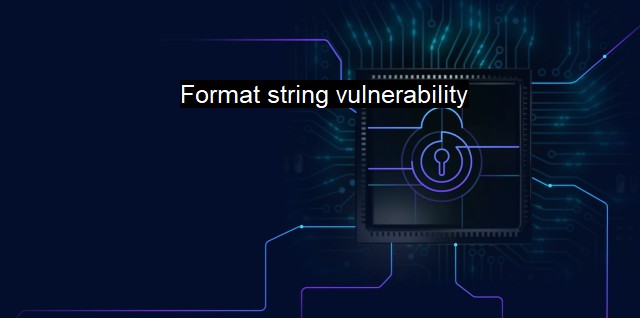What is Format string vulnerability?
Understanding the Danger of Format String Vulnerabilities: Exploiting a Vulnerable Software System with Ease
A "Format String Vulnerability" is a serious security vulnerability that occurs in software programming. Its occurrence originates from the usage of unfiltered user-input as the format string parameter in certain C standard library functions which perform formatting, such as printf() and sprintf(). Typically, these SW security vulnerabilities can pave the way for potential security attacks like reading data from the program's memory, causing the application to crash or leading to the execution of arbitrary code by attackers.Delving into the genesis of Format String Vulnerabilities, they come into play when a programmer chooses to avoid specifying the format string in a formatting function clearly, and instead, feeds an externally provided string as the format string. In other words, it occurs when the data supplied by a user is directly formatted and output without appropriate validation. CWE, the common weaknesses enumeration repository, lists ‘Format String Vulnerability’ as 'CWE-134: Uncontrolled Format String.'
When a format string function is presented without a matching format string, the program tries to fetch arguments that don't exist. This significant malfunctioning can provide unintended access to application memory or lead to unintended behaviors. More malevolent or competent attackers may utilize this vulnerability to execute malicious code or instigate a crash-to-root-attack—a type of vulnerability where a hacker crashes a program running with elevated privileges, taking over those privileges.
A Format String Vulnerability could lead to several risky scenarios which extensively vary due to the extent of control an attacker can gain as per memory layout or program data to manipulate. From users reading sensitive information from a process's memory, which can leak out confidential credentials, they can potentially alter the execution flow of applications by overwriting function pointers or other critical control structures in memory. Even worse, they may implant and execute their code, leading to complete breach or compromise of the system.
Simulation code defects which demonstrate Format String Vulnerabilities often look like innocent printf statements. But if an attacker can control the functions' argument, they can cause the function to overwrite parts of the program state or make it publish parts of the program's memory to output streams.
Blunting the teeth of Format String Vulnerabilities require vigilant and efficient measures through secure coding techniques. Developers must ensure that format functions are used with static format strings and user-controlled input should not be passed directly.
Implementation of robust cyber security practices is of utmost importance in this regard. Security solutions and software, including antivirus programs, firewalls, and advanced threat management solutions, need continuous updates or patching against known vulnerabilities. Companies often use a range of security penetration testing methodologies to validate the vulnerabilities.
Educated system users also play a central role in implementing updates, scanning for threats, and maintaining overall security hygiene. In an age where cyber threats emerge and evolve rapidly, dynamic precautions at all levels are imperative to protect information infrastructure and ensure resilience against cyber threats.
'Format String Vulnerability' is a critical stumbling block that a programmer may encounter in the trail of coding. A comprehensive awareness of Format String Vulnerabilities, the risks they pose, and the potential measures to tackle them is indispensable. Amidst the expanding landscape of diverse cyber attacks facing modern enterprises, countering such vulnerabilities plays a key role in lifting the entire cybersecurity pose. Awareness and secure coding practices can go a long way toward minimizing the risks posed by Format String Vulnerabilities. So can dedicated and updated cybersecurity stewardship and antivirus programs, along with knowledgeable and vigilant users.

Format string vulnerability FAQs
What is a format string vulnerability in cybersecurity?
A format string vulnerability is a type of software vulnerability that occurs when the input provided by a user is not properly validated. This vulnerability can be exploited by an attacker to execute arbitrary code or cause a denial of service on the target machine.How does a format string vulnerability work?
A format string vulnerability works by exploiting the format string function in programming languages like C and C++. This function is used to format strings and other data types, but if the input provided by a user is not properly validated, it can cause the function to read or write data to memory locations that are not intended, leading to the exploitation of the vulnerability.What are the consequences of a format string vulnerability?
The consequences of a format string vulnerability can be severe, as it can provide an attacker with the ability to execute arbitrary code or cause a denial of service on the target machine. This can result in data theft, system damage, and other serious consequences.How can I protect my system from format string vulnerabilities?
To protect your system from format string vulnerabilities, you should always ensure that your software is up-to-date and that you use secure coding practices when developing your own software. Additionally, you should consider using antivirus software that can detect and block attacks that exploit format string vulnerabilities.| | A | | | B | | | C | | | D | | | E | | | F | | | G | | | H | | | I | | | J | | | K | | | L | | | M | |
| | N | | | O | | | P | | | Q | | | R | | | S | | | T | | | U | | | V | | | W | | | X | | | Y | | | Z | |
| | 1 | | | 2 | | | 3 | | | 4 | | | 7 | | | 8 | | |||||||